A&A 401, 1177-1183 (2003)
DOI: 10.1051/0004-6361:20030131
M. C. Chidichimo 1 - N. R. Badnell 2 - J. A. Tully 3
1 - Department of Applied Mathematics, University of Waterloo,
Waterloo, Ontario N2L 3G1, Canada
2 -
Department of Physics, University of Strathclyde,
Glasgow G4 0NG, UK
3 -
Observatoire de la Côte d'Azur, Département Gian Domenico Cassini,
BP 4229, 06304 Nice Cedex 4, France
Received 31 October 2002 / Accepted 28 January 2003
Abstract
This paper reports on the calculation of collision strengths for electron
induced transitions in the beryllium-like ion Ni XXV whose ground state
is
![]() .
We make use of the R-matrix method in conjunction
with the intermediate frame coupling transformation (IFCT).
The target has 98 fine structure states
.
We make use of the R-matrix method in conjunction
with the intermediate frame coupling transformation (IFCT).
The target has 98 fine structure states
![]() corresponding to n = 2 and
n' = 2, 3, 4.
Our calculation extends up to 440 Ry with respect to the ground state.
In order to obtain reliable rate coefficients at high temperatures (T above
corresponding to n = 2 and
n' = 2, 3, 4.
Our calculation extends up to 440 Ry with respect to the ground state.
In order to obtain reliable rate coefficients at high temperatures (T above
![]() K) we have extended our collision strengths to much higher
energies by using a variety of techniques, including use of Burgess's
interactive code OmeUps.
The effective collision strength
K) we have extended our collision strengths to much higher
energies by using a variety of techniques, including use of Burgess's
interactive code OmeUps.
The effective collision strength
![]() is
tabulated against
is
tabulated against
![]() for the 45 transitions linking the lowest
10 levels. We also give results for 5 transitions in the X-ray region which are
needed in solar studies. The temperature range
for the 45 transitions linking the lowest
10 levels. We also give results for 5 transitions in the X-ray region which are
needed in solar studies. The temperature range
![]() is
centred on
is
centred on
![]() which is where this ion has its maximum
coronal abundance.
which is where this ion has its maximum
coronal abundance.
Key words: atomic data
Here we present results for beryllium-like nickel, Ni+24. In 1992 there
appeared a hefty publication by Zhang & Sampson devoted to collisional
excitation of this ion, with earlier work by Sampson and his colleagues being
reported by Goett et al. (1980). Another team in the United States also
produced tables of effective collision strengths (Bhatia et al. 1986). All
these earlier calculations made use of distorted wave methods that take
account of electron exchange and relativistic effects.
| nl | cjnl | Ijnl |
|
|
| 1s | 0.98789 | 1 | 27.51310 | |
| 0.01097 | 1 | 48.93450 | ||
| -0.00004 | 2 | 12.72440 | ||
| 0.00320 | 2 | 21.97850 | ||
| 2s | -0.33875 | 1 | 27.51310 | |
| 0.00059 | 1 | 48.93450 | ||
| 1.29943 | 2 | 12.72440 | ||
| -0.30984 | 2 | 21.97850 | ||
| 3s | 0.36943 | 1 | 17.12263 | |
| -3.29172 | 2 | 7.29109 | ||
| 3.76773 | 3 | 8.25358 | ||
| 4s | 0.25004 | 1 | 16.24011 | |
| -3.94079 | 2 | 5.78564 | ||
| 11.62791 | 3 | 5.71076 | ||
| -8.67396 | 4 | 6.16419 | ||
| 2p | 0.97880 | 2 | 12.84069 | |
| 0.02563 | 2 | 22.53802 | ||
| 3p | 0.93402 | 2 | 10.80721 | |
| -1.48168 | 3 | 8.15175 | ||
| 4p | 0.83985 | 2 | 9.55737 | |
| -3.84500 | 3 | 6.19587 | ||
| 3.78083 | 4 | 6.20918 | ||
| 3d | 1.00000 | 3 | 8.46223 | |
| 4d | 1.34954 | 3 | 7.16910 | |
| -1.83248 | 4 | 6.13833 | ||
| 4f | 1.00000 | 4 | 6.25668 |
Clementi & Roetti (1973) is an excellent source of atomic wavefunctions and
we have used their
![]() radial orbitals while calculating
radial orbitals while calculating
![]() ourselves with the configuration
interaction program CIV3 (Hibbert 1975; Hibbert et al. 1991). CIV3 uses
analytic radial orbitals Pnl(r) which are expressed as sums of Slater
type orbitals as follows :
ourselves with the configuration
interaction program CIV3 (Hibbert 1975; Hibbert et al. 1991). CIV3 uses
analytic radial orbitals Pnl(r) which are expressed as sums of Slater
type orbitals as follows :
![\begin{displaymath}P_{nl}(r) = \sum_{j=1}^k c_{jnl}~ {{(2 \zeta_{jnl})^{I_{jnl}+...
..._{jnl})!]^{1\over2}}}~ r^{I_{jnl}}~ {\rm exp}(-\zeta_{jnl}~ r).\end{displaymath}](/articles/aa/full/2003/15/aa3249/img28.gif)
Our ultimate aim is to tabulate the temperature dependent effective
collision strength
![]() ,
defined by:
,
defined by:

|

|
| S | f | A | Transition | |||||
| 1.655-3 | 2.096-3 | 8.106+7 | 2.398+2 | 1-3 | ||||
| 5.763-2 | 1.488-1 | 2.376+10 | 1.177+2 | 1-5 | ||||
| 7.325-3 | 2.373-1 | 6.002+12 | 9.376+0 | 1-14 | ||||
| 1.320-2 | 4.293-1 | 1.094+13 | 9.339+0 | 1-15 | ||||
| 2.621-2 | 6.150-2 | 8.170+9 | 1.294+2 | 2-7 | ||||
| 2.696-2 | 1.715-2 | 1.356+10 | 1.591+2 | 3-6 | ||||
| 1.891-2 | 1.400-2 | 4.999+9 | 1.367+2 | 3-7 | ||||
| 3.425-2 | 2.736-2 | 6.824+9 | 1.267+2 | 3-8 | ||||
| 2.058-3 | 2.000-3 | 7.371+8 | 1.042+2 | 3-9 | ||||
| 6.960-5 | 8.407-5 | 2.395+8 | 8.382+1 | 3-10 | ||||
| 5.183-2 | 5.457-1 | 2.361+13 | 9.617+0 | 3-18 | ||||
| 3.239-2 | 1.185-2 | 4.782+9 | 1.660+2 | 4-7 | ||||
| 6.592-2 | 2.644-2 | 7.682+9 | 1.515+2 | 4-8 | ||||
| 3.198-2 | 1.614-2 | 7.443+9 | 1.203+2 | 4-9 | ||||
| 1.402-3 | 2.775-4 | 2.123+7 | 5.115+2 | 5-6 | ||||
| 6.763-4 | 2.043-4 | 1.213+7 | 3.352+2 | 5-7 | ||||
| 2.955-2 | 1.066-2 | 5.408+8 | 2.808+2 | 5-8 | ||||
| 9.541-2 | 5.089-2 | 5.654+9 | 1.898+2 | 5-9 | ||||
| 4.253-2 | 3.273-2 | 3.781+10 | 1.316+2 | 5-10 | ||||
| 9.793-4 | 9.624-3 | 1.816+12 | 1.030+1 | 5-12 | ||||
| 5.473-2 | 5.566-1 | 2.247+13 | 9.956+0 | 5-20 |
| gf(AS) |
|
Transition | ||||
| 9.376 | 9.381 | 0.2373 | 0.21 | 1-14 | ||
| 9.339 | 9.341 | 0.4293 | 0.45 | 1-15 | ||
| 9.892 | 9.917 | 0.0235 | 0.027 | 2-11 | ||
| 9.339 | 9.347 | 0.0534 | 0.084 | 2-23 | ||
| 9.269 | 9.172 | 0.0144 | 0.014 | 2-31 | ||
| 9.933 | 9.957 | 0.0703 | 0.077 | 3-11 | ||
| 9.623 | 9.632 | 0.5430 | 0.54 | 3-17 | ||
| 9.375 | 9.382 | 0.1155 | 0.16 | 3-23 | ||
| 9.304 | 9.206 | 0.0688 | 0.082 | 3-25 | ||
| 9.304 | 9.312 | 0.3809 | 0.51 | 3-26 | ||
| 9.294 | 9.302 | 0.1113 | 0.12 | 3-28 | ||
| 9.177 | 9.187 | 0.0140 | 0.01 | 3-35 | ||
| 10.061 | 10.082 | 0.1274 | 0.13 | 4-11 | ||
| 9.744 | 9.748 | 0.0366 | 0.036 | 4-17 | ||
| 9.738 | 9.743 | 0.5434 | 0.53 | 4-18 | ||
| 9.728 | 9.734 | 3.0395 | 2.98 | 4-19 | ||
| 9.417 | 9.421 | 0.0047 | 0.01 | 4-26 | ||
| 9.417 | 9.314 | 0.0764 | 0.096 | 4-31 | ||
| 9.296 | 9.300 | 0.5602 | 0.75 | 4-33 | ||
| 9.287 | 9.294 | 0.3957 | 0.45 | 4-35 | ||
| 10.304 | 10.321 | 0.0289 | 0.032 | 5-12 | ||
| 9.956 | 9.966 | 1.6698 | 1.82 | 5-20 | ||
| 10.231 | 10.233 | 0.0856 | 0.077 | 8-22 | ||
| 10.078 | 10.080 | 0.1738 | 0.16 | 8-24 | ||
| 9.767 | 9.770 | 2.9566 | 2.95 | 8-40 | ||
| 10.192 | 10.194 | 0.0536 | 0.048 | 7-21 | ||
| 10.171 | 10.174 | 0.0304 | 0.028 | 7-22 | ||
| 10.020 | 10.023 | 0.1164 | 0.11 | 7-24 | ||
| 10.066 | 10.073 | 0.0563 | 0.055 | 6-22 | ||
| 10.204 | 10.204 | 0.1380 | 0.13 | 9-27 | ||
| 9.846 | 9.853 | 4.6880 | 4.88 | 9-45 | ||
| 10.453 | 10.454 | 0.0605 | 0.054 | 10-27 |
We determined effective collision strengths for five additional transitions because of their special astrophysical interest. The transitions are 1-14, 1-15, 3-18, 5-12, 5-20 and results are given in Table 6.
Figures 1 to 6 show the collision strengths for the 45 transitions between
the lowest 10 levels. In each case the energy is measured relative to the final
state of the transition, i.e.
![]() is plotted against Ej where the
index j refers to the upper level. The range covers
is plotted against Ej where the
index j refers to the upper level. The range covers
![]() Ry.
The ordinate scale is adjusted so that the highest peak touches the top of its
box.
Ry.
The ordinate scale is adjusted so that the highest peak touches the top of its
box.
The higher a peak the narrower the resonance is likely to be. In order to
avoid the possibility of getting unrealistically large contributions to
![]() from isolated peaks in
from isolated peaks in
![]() ,
we used a small
constant step in energy of 0.0196418 rydbergs in the interval
,
we used a small
constant step in energy of 0.0196418 rydbergs in the interval
![]() .
The computing took nearly 350 hours on a Sun Ultra Enterprise 450 SunOS 5.6,
with the output occupying about 15 Mb of computer space after being compressed.
.
The computing took nearly 350 hours on a Sun Ultra Enterprise 450 SunOS 5.6,
with the output occupying about 15 Mb of computer space after being compressed.
One can see that we have succeeded in catching a few isolated high points,
but how many more have succeeded in slipping through the net we cannot tell.
One case of special interest is the transition 4-5 for which two
peaks are so close to threshold (E5 = 0) that they are indistinguishable
from the ordinate axis. We replot both peaks in Fig. 7 where, in order to
delineate them, we have increased the number of data points in the two
narrow energy intervals where the resonances occur. The inclusion of these
additional data points in the collision strength file causes
![]() to change from 0.0626 at
to change from 0.0626 at
![]() to 0.0382, a decrease of 40 per cent.
At
to 0.0382, a decrease of 40 per cent.
At
![]() the decrease is 15%, which is a lot smaller but still
not insignificant.
the decrease is 15%, which is a lot smaller but still
not insignificant.
By altering the scale of the ordinate axis the dense "undergrowth'' caused
by resonances can be made visible. Alternatively one can plot the logarithm
of
![]() ,
as is done in Fig. 8 for the eight transitions shown
in Fig. 1.
The complicated structure is very impressive but its effect on the thermally
averaged collision strengths is often overshadowed by the effect of the
isolated peaks which appear clearly in Figs. 1 to 6.
,
as is done in Fig. 8 for the eight transitions shown
in Fig. 1.
The complicated structure is very impressive but its effect on the thermally
averaged collision strengths is often overshadowed by the effect of the
isolated peaks which appear clearly in Figs. 1 to 6.
Since the present investigation began, one of us (NRB) has attended to
the thorny problem of how best to deal with the resonances that pepper
collision strengths. As a result some guidelines have been proposed by
Badnell & Griffin (2001) and Badnell et al. (2001). The steplength we used
is close to
![]() Ry, the largest steplength
recommended by Badnell et al. (2001). In retrospect we see that a smaller
value than this would have been preferable in certain energy intervals covered
by our calculation.
Ry, the largest steplength
recommended by Badnell et al. (2001). In retrospect we see that a smaller
value than this would have been preferable in certain energy intervals covered
by our calculation.
| i-j | 6.3 | 6.5 | 6.7 | 6.9 | 7.1 | 7.3 | 7.5 | 7.7 | 7.9 | 8.1 | 8.3 |
| 1-2 | 1.837-3 | 2.018-3 | 2.068-3 | 1.942-3 | 1.681-3 | 1.360-3 | 1.046-3 | 7.747-4 | 5.575-4 | 3.929-4 | 2.726-4 |
| 1-3 | 1.631-2 | 1.685-2 | 1.731-2 | 1.756-2 | 1.761-2 | 1.764-2 | 1.776-2 | 1.802-2 | 1.843-2 | 1.894-2 | 1.954-2 |
| 1-4 | 1.144-2 | 1.162-2 | 1.132-2 | 1.031-2 | 8.750-3 | 6.985-3 | 5.318-3 | 3.910-3 | 2.803-3 | 1.976-3 | 1.376-3 |
| 1-5 | 2.801-1 | 2.908-1 | 3.048-1 | 3.226-1 | 3.444-1 | 3.705-1 | 4.006-1 | 4.341-1 | 4.699-1 | 5.068-1 | 5.450-1 |
| 1-6 | 1.844-4 | 2.110-4 | 2.369-4 | 2.477-4 | 2.366-4 | 2.102-4 | 1.790-4 | 1.499-4 | 1.259-4 | 1.074-4 | 9.374-5 |
| 1-7 | 1.943-4 | 2.312-4 | 2.591-4 | 2.627-4 | 2.375-4 | 1.946-4 | 1.481-4 | 1.069-4 | 7.451-5 | 5.062-5 | 3.380-5 |
| 1-8 | 6.326-4 | 7.018-4 | 7.508-4 | 7.585-4 | 7.250-4 | 6.703-4 | 6.156-4 | 5.721-4 | 5.422-4 | 5.239-4 | 5.140-4 |
| 1-9 | 8.529-4 | 9.245-4 | 9.668-4 | 9.678-4 | 9.335-4 | 8.850-4 | 8.410-4 | 8.103-4 | 7.932-4 | 7.866-4 | 7.867-4 |
| 1-10 | 6.353-4 | 7.062-4 | 7.548-4 | 7.569-4 | 7.124-4 | 6.415-4 | 5.650-4 | 4.948-4 | 4.355-4 | 3.880-4 | 3.515-4 |
| 2-3 | 2.749-2 | 2.439-2 | 2.172-2 | 1.887-2 | 1.569-2 | 1.243-2 | 9.458-3 | 6.960-3 | 4.991-3 | 3.509-3 | 2.432-3 |
| 2-4 | 1.890-2 | 1.770-2 | 1.657-2 | 1.509-2 | 1.333-2 | 1.159-2 | 1.010-2 | 8.969-3 | 8.150-3 | 7.590-3 | 7.226-3 |
| 2-5 | 5.371-3 | 6.122-3 | 6.401-3 | 6.049-3 | 5.198-3 | 4.137-3 | 3.112-3 | 2.249-3 | 1.579-3 | 1.087-3 | 7.388-4 |
| 2-6 | 1.232-3 | 1.245-3 | 1.242-3 | 1.174-3 | 1.032-3 | 8.483-4 | 6.603-4 | 4.932-4 | 3.573-4 | 2.531-4 | 1.765-4 |
| 2-7 | 1.316-1 | 1.367-1 | 1.434-1 | 1.517-1 | 1.619-1 | 1.740-1 | 1.878-1 | 2.031-1 | 2.191-1 | 2.355-1 | 2.522-1 |
| 2-8 | 3.042-3 | 3.413-3 | 3.595-3 | 3.477-3 | 3.079-3 | 2.529-3 | 1.963-3 | 1.461-3 | 1.055-3 | 7.454-4 | 5.182-4 |
| 2-9 | 1.454-3 | 1.888-3 | 2.034-3 | 1.900-3 | 1.587-3 | 1.221-3 | 8.875-4 | 6.199-4 | 4.218-4 | 2.820-4 | 1.864-4 |
| 2-10 | 2.966-4 | 3.674-4 | 3.873-4 | 3.585-4 | 2.983-4 | 2.288-4 | 1.656-4 | 1.151-4 | 7.791-5 | 5.177-5 | 3.398-5 |
| 3-4 | 7.408-2 | 6.853-2 | 6.331-2 | 5.674-2 | 4.891-2 | 4.098-2 | 3.400-2 | 2.844-2 | 2.430-2 | 2.133-2 | 1.927-2 |
| 3-5 | 2.751-2 | 2.582-2 | 2.416-2 | 2.160-2 | 1.816-2 | 1.446-2 | 1.108-2 | 8.326-3 | 6.236-3 | 4.725-3 | 3.667-3 |
| 3-6 | 1.353-1 | 1.412-1 | 1.492-1 | 1.596-1 | 1.722-1 | 1.868-1 | 2.031-1 | 2.206-1 | 2.386-1 | 2.567-1 | 2.751-1 |
| 3-7 | 9.960-2 | 1.037-1 | 1.089-1 | 1.150-1 | 1.222-1 | 1.306-1 | 1.403-1 | 1.510-1 | 1.625-1 | 1.744-1 | 1.868-1 |
| 3-8 | 1.799-1 | 1.874-1 | 1.963-1 | 2.065-1 | 2.183-1 | 2.322-1 | 2.486-1 | 2.672-1 | 2.877-1 | 3.091-1 | 3.316-1 |
| 3-9 | 1.560-2 | 1.726-2 | 1.813-2 | 1.824-2 | 1.791-2 | 1.755-2 | 1.741-2 | 1.758-2 | 1.804-2 | 1.871-2 | 1.957-2 |
| 3-10 | 1.441-3 | 1.678-3 | 1.764-3 | 1.689-3 | 1.500-3 | 1.273-3 | 1.066-3 | 9.092-4 | 8.037-4 | 7.425-4 | 7.156-4 |
| 4-5 | 3.822-2 | 3.679-2 | 3.482-2 | 3.120-2 | 2.615-2 | 2.063-2 | 1.554-2 | 1.135-2 | 8.129-3 | 5.771-3 | 4.103-3 |
| 4-6 | 1.297-3 | 1.471-3 | 1.578-3 | 1.534-3 | 1.345-3 | 1.080-3 | 8.136-4 | 5.860-4 | 4.097-4 | 2.810-4 | 1.904-4 |
| 4-7 | 1.690-1 | 1.766-1 | 1.867-1 | 1.992-1 | 2.142-1 | 2.315-1 | 2.507-1 | 2.714-1 | 2.928-1 | 3.143-1 | 3.359-1 |
| 4-8 | 3.425-1 | 3.576-1 | 3.769-1 | 4.005-1 | 4.286-1 | 4.613-1 | 4.982-1 | 5.385-1 | 5.806-1 | 6.233-1 | 6.669-1 |
| 4-9 | 1.774-1 | 1.851-1 | 1.932-1 | 2.015-1 | 2.107-1 | 2.217-1 | 2.348-1 | 2.497-1 | 2.658-1 | 2.823-1 | 2.992-1 |
| 4-10 | 3.018-3 | 3.470-3 | 3.595-3 | 3.368-3 | 2.882-3 | 2.293-3 | 1.728-3 | 1.254-3 | 8.850-4 | 6.126-4 | 4.184-4 |
| 5-6 | 7.162-3 | 7.917-3 | 8.767-3 | 9.685-3 | 1.074-2 | 1.195-2 | 1.327-2 | 1.461-2 | 1.590-2 | 1.712-2 | 1.827-2 |
| 5-7 | 9.157-3 | 9.627-3 | 1.001-2 | 1.008-2 | 9.838-3 | 9.443-3 | 9.076-3 | 8.825-3 | 8.707-3 | 8.703-3 | 8.793-3 |
| 5-8 | 1.747-1 | 1.844-1 | 1.962-1 | 2.096-1 | 2.249-1 | 2.423-1 | 2.616-1 | 2.822-1 | 3.032-1 | 3.241-1 | 3.449-1 |
| 5-9 | 5.264-1 | 5.493-1 | 5.781-1 | 6.132-1 | 6.553-1 | 7.045-1 | 7.598-1 | 8.193-1 | 8.803-1 | 9.407-1 | 1.000 |
| 5-10 | 2.145-1 | 2.227-1 | 2.335-1 | 2.468-1 | 2.625-1 | 2.806-1 | 3.006-1 | 3.222-1 | 3.445-1 | 3.669-1 | 3.898-1 |
| 6-7 | 1.731-2 | 1.959-2 | 2.051-2 | 1.955-2 | 1.705-2 | 1.384-2 | 1.065-2 | 7.886-3 | 5.684-3 | 4.023-3 | 2.813-3 |
| 6-8 | 1.584-2 | 1.708-2 | 1.764-2 | 1.721-2 | 1.594-2 | 1.431-2 | 1.273-2 | 1.141-2 | 1.040-2 | 9.679-3 | 9.174-3 |
| 6-9 | 4.859-3 | 6.210-3 | 6.779-3 | 6.432-3 | 5.450-3 | 4.248-3 | 3.125-3 | 2.213-3 | 1.530-3 | 1.045-3 | 7.106-4 |
| 6-10 | 1.615-3 | 2.142-3 | 2.415-3 | 2.347-3 | 2.013-3 | 1.572-3 | 1.148-3 | 8.022-4 | 5.436-4 | 3.612-4 | 2.370-4 |
| 7-8 | 4.631-2 | 5.113-2 | 5.305-2 | 5.096-2 | 4.559-2 | 3.871-2 | 3.195-2 | 2.618-2 | 2.165-2 | 1.828-2 | 1.585-2 |
| 7-9 | 3.054-2 | 3.478-2 | 3.642-2 | 3.479-2 | 3.064-2 | 2.542-2 | 2.037-2 | 1.612-2 | 1.282-2 | 1.040-2 | 8.683-3 |
| 7-10 | 6.308-3 | 7.518-3 | 7.909-3 | 7.410-3 | 6.285-3 | 4.932-3 | 3.656-3 | 2.604-3 | 1.803-3 | 1.224-3 | 8.198-4 |
| 8-9 | 7.110-2 | 8.133-2 | 8.555-2 | 8.247-2 | 7.390-2 | 6.313-2 | 5.284-2 | 4.432-2 | 3.784-2 | 3.318-2 | 2.993-2 |
| 8-10 | 1.114-2 | 1.281-2 | 1.338-2 | 1.278-2 | 1.140-2 | 9.779-3 | 8.302-3 | 7.134-3 | 6.285-3 | 5.701-3 | 5.311-3 |
| 9-10 | 2.010-2 | 2.186-2 | 2.282-2 | 2.277-2 | 2.200-2 | 2.101-2 | 2.017-2 | 1.963-2 | 1.936-2 | 1.927-2 | 1.928-2 |
| logT |
|
|
|
|
|
|||||
| 6.3 | 4.138-3 | 6.108-3 | 5.272-2 | 5.685-3 | 6.329-2 | |||||
| 6.5 | 4.102-3 | 6.265-3 | 5.443-2 | 4.098-3 | 6.511-2 | |||||
| 6.7 | 4.204-3 | 6.626-3 | 5.696-2 | 2.979-3 | 6.782-2 | |||||
| 6.9 | 4.502-3 | 7.304-3 | 6.083-2 | 2.236-3 | 7.208-2 | |||||
| 7.1 | 5.056-3 | 8.419-3 | 6.654-2 | 1.785-3 | 7.845-2 | |||||
| 7.3 | 5.922-3 | 1.007-2 | 7.450-2 | 1.558-3 | 8.736-2 | |||||
| 7.5 | 7.140-3 | 1.234-2 | 8.499-2 | 1.504-3 | 9.901-2 | |||||
| 7.7 | 8.734-3 | 1.527-2 | 9.814-2 | 1.583-3 | 1.134-1 | |||||
| 7.9 | 1.068-2 | 1.883-2 | 1.137-1 | 1.765-3 | 1.305-1 | |||||
| 8.1 | 1.296-2 | 2.297-2 | 1.315-1 | 2.025-3 | 1.497-1 | |||||
| 8.3 | 1.559-2 | 2.774-2 | 1.517-1 | 2.353-3 | 1.715-1 |
| i,j | CBT | BFS | ZS | i,j | CBT | BFS | ZS | i,j | CBT | BFS | ZS | ||
| 1,2 | 1.71-3 | 5.99-4 | 7.98-4 | 2,9 | 1.62-3 | 1.62-4 | 2.08-4 | 5,6 | 1.06-2 | 1.45-2 | 1.29-2 | ||
| 1,3 | 1.76-2 | 1.46-2 | 1.39-2 | 2,10 | 3.05-4 | 2.70-5 | 3.50-5 | 5,7 | 9.87-3 | 7.46-3 | 7.06-3 | ||
| 1,4 | 8.93-3 | 2.83-3 | 3.85-3 | 3,4 | 4.98-2 | 2.03-2 | 2.58-2 | 5,8 | 2.23-1 | 5.68-2 | 2.22-1 | ||
| 1,5 | 3.42-1 | 3.45-1 | 3.43-1 | 3,5 | 1.86-2 | 4.85-3 | 6.50-3 | 5,9 | 6.51-1 | 6.98-1 | 6.59-1 | ||
| 1,6 | 2.39-4 | 7.70-5 | 9.61-5 | 3,6 | 1.71-1 | 1.76-1 | 1.74-1 | 5,10 | 2.61-1 | 2.84-1 | 2.70-1 | ||
| 1,7 | 2.41-4 | 5.20-5 | 8.68-5 | 3,7 | 1.21-1 | 1.19-1 | 1.21-1 | 6,7 | 1.74-2 | 6.09-3 | 8.56-3 | ||
| 1,8 | 7.30-4 | 4.10-4 | 3.77-4 | 3,8 | 2.17-1 | 2.06-1 | 2.17-1 | 6,8 | 1.61-2 | 9.24-3 | 1.10-2 | ||
| 1,9 | 9.38-4 | 6.04-4 | 4.97-4 | 3,9 | 1.80-2 | 1.28-2 | 1.24-2 | 6,9 | 5.57-3 | 8.66-4 | 1.27-3 | ||
| 1,10 | 7.19-4 | 3.08-4 | 2.59-4 | 3,10 | 1.52-3 | 4.19-4 | 5.49-4 | 6,10 | 1.97-3 | 1.62-4 | 2.44-4 | ||
| 2,3 | 1.60-2 | 5.52-3 | 8.16-3 | 4,5 | 3.10-2 | 7.19-3 | 1.04-2 | 7,8 | 4.63-2 | 2.06-2 | 2.67-2 | ||
| 2,4 | 1.35-2 | 6.29-3 | 7.34-3 | 4,6 | 1.37-3 | 2.29-4 | 3.00-4 | 7,9 | 3.11-2 | 1.16-2 | 1.53-2 | ||
| 2,5 | 5.30-3 | 1.36-3 | 1.94-3 | 4,7 | 2.13-1 | 2.32-1 | 2.13-1 | 7,10 | 6.42-3 | 1.36-3 | 2.03-3 | ||
| 2,6 | 1.04-3 | 4.00-4 | 5.39-4 | 4,8 | 4.26-1 | 4.57-1 | 4.27-1 | 8,9 | 7.50-2 | 3.11-2 | 3.79-2 | ||
| 2,7 | 1.61-1 | 1.68-1 | 1.63-1 | 4,9 | 2.10-1 | 2.01-1 | 2.01-1 | 8,10 | 1.16-2 | 4.72-3 | 5.60-3 | ||
| 2,8 | 3.13-3 | 1.14-3 | 1.52-3 | 4,10 | 2.94-3 | 7.74-4 | 1.04-3 | 9,10 | 2.21-2 | 1.48-2 | 1.64-2 |
Zhang & Sampson (1992), hereafter ZS, give collision strengths for
Ej= 19.5075, 52.02, 130.05, 273.105, 520.20, 910.35 Ry. We used linear
extrapolation to estimate the value of
![]() at Ej = 0 and then
thermally averaged the data in order to obtain
at Ej = 0 and then
thermally averaged the data in order to obtain
![]() at
at
![]() .
Table 8 is a comparison of the present
results (CBT) with those of BFS and ZS.
.
Table 8 is a comparison of the present
results (CBT) with those of BFS and ZS.
From Table 8 we see that for optically allowed transitions between states with the same spin multiplicity the agreement between CBT and ZS is excellent. For optically allowed transitions between singlet and triplet states the agreement is almost perfect in the case of (5, 8) where CBT/ZS = 1.004 but otherwise varies from between CBT/ZS = 0.82 for (5, 6) up to CBT/ZS = 2.77 for (3, 10). The excellent agreement between CBT and ZS for (5, 8) is not duplicated by BFS since their result, curiously enough, is almost a factor of 4 smaller.
For the remaining transitions ![]() (CBT) always exceeds
(CBT) always exceeds ![]() (BFS)
and
(BFS)
and ![]() (ZS) by a factor not exceeding 5, except for the transitions (2, 9), (2, 10) and (6, 10). The reason for this is undoubtedly the neglect by
BFS and ZS of resonances, which in our calculation occur in great profusion
and have a pronounced effect on the collision strengths of optically
forbidden transitions.
(ZS) by a factor not exceeding 5, except for the transitions (2, 9), (2, 10) and (6, 10). The reason for this is undoubtedly the neglect by
BFS and ZS of resonances, which in our calculation occur in great profusion
and have a pronounced effect on the collision strengths of optically
forbidden transitions.
Acknowledgements
Dr. Helen E. Mason (Cambridge, UK) drew our attention to the transitions in Table 6 and told us that electron rate coefficients for them are likely to be needed by those studying the Sun at X-ray wavelengths. Alan Burgess (Cambridge, UK), David G. Hummer (Boulder) and Honglin Zhang (Los Alamos) provided us with suggestions for improving the content and presentation. Arati Pai, undergraduate in the Department of Electrical Engineering, University of Waterloo, undertook the running of Burgess's codes and we wish to thank her for assisting us. Finally, MCC acknowledges support by the Natural Sciences and Engineering Research Council of Canada.
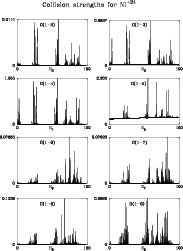 |
Figure 1:
Collision strength
|
| Open with DEXTER | |
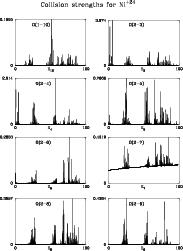 |
Figure 2:
Collision strength
|
| Open with DEXTER | |
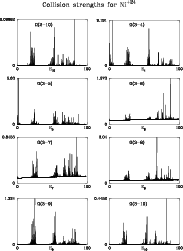 |
Figure 3:
Collision strength
|
| Open with DEXTER | |
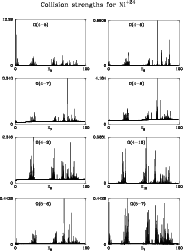 |
Figure 4:
Collision strength
|
| Open with DEXTER | |
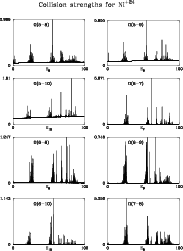 |
Figure 5:
Collision strength
|
| Open with DEXTER | |
 |
Figure 6:
Collision strength
|
| Open with DEXTER | |
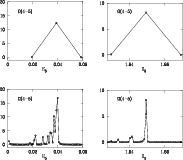 |
Figure 7:
Collision strength
|
| Open with DEXTER | |
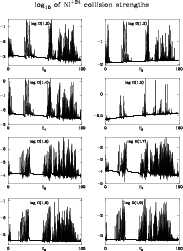 |
Figure 8:
Logarithm of
|
| Open with DEXTER | |
Appendix A: High energy Born limits: Intercombination transitions and configuration interaction (CI)